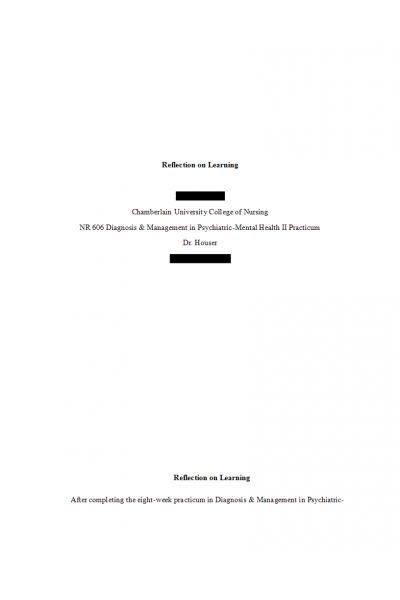NR 606 Week 8 Assignment; Reflection on Learning
-
$20.00
| Institution | Chamberlain |
| Contributor | Mikey Madison |
This assignment is due by Saturday at 11:59 p.m. MT of Week 8. Nothing can be accepted AFTER the Week 8 deadline when the course closes.
The course ends on Saturday of Week 8. There is no late submission allowed for this assignment.
Preparing the Assignment
Follow these guidelines when completing this assignment. Contact your course faculty if you have questions.
- Describe how the assigned readings, ctivities, assessments, and clinical experiences in this course helped you to meet Program Outcome 5: Advocates for positive health outcomes through compassionate, evidence-based, collaborative advanced nursing practice. (Extraordinary Nursing) Provide at least two specific examples.
- Select one of the competencies from AACN Essentials Domain
3 listed below and describe how learning in this course helped you to meet the advanced-level nursing education competency. Provide at least two specific examples.
- 3.1 Manage population health
- 3.1j Assess the efficacy of a system’s capability to serve a target sub-population’s healthcare needs.
- 3.1k Analyze primary and secondary population health data for multiple populations against relevant benchmarks.
- 3.1l Use established or evolving methods to determine population-focused priorities for care.
- 3.1m Develop a collaborative approach with relevant stakeholders to address population healthcare needs, including evaluation methods.
- 3.1n Collaborate with appropriate stakeholders to implement a sociocultural and linguistically responsive intervention plan.
- 3.2 Engage in effective partnerships
- 3.2d Ascertain collaborative opportunities for individuals and organizations to improve population health.
- 3.2e Challenge biases and barriers that impact population health outcomes.
- 3.2f Evaluate the effectiveness of partnerships for achieving health equity.
- 3.2g Lead partnerships to improve population health outcomes.
- 3.2h Assess preparation and readiness of partners to organize during natural and manmade disasters.
- 3.3 Consider the socioeconomic impact of the delivery of health care.
- 3.3c Analyze cost-benefits of selected population-based interventions.
- 3.3d Collaborate with partners to secure and leverage resources necessary for effective, sustainable interventions.
- 3.3e Advocate for interventions that maximize cost- effective, accessible, and equitable resources for populations.
- 3.3f Incorporate ethical principles in resource allocation in achieving equitable health.
- 3.4 Advance equitable population health policy
- 3.4f Identify opportunities to influence the policy process.
- 3.4g Design comprehensive advocacy strategies to support the policy process.
- 3.4h Engage in strategies to influence policy change.
- 3.4i Contribute to policy development at the system, local, regional, or national levels.
- 3.4j Assess the impact of policy changes.
- 3.4k Evaluate the ability of policy to address disparities and inequities within segments of the population.
- 3.4l Evaluate the risks to population health associated with globalization.
- 3.5f Appraise advocacy priorities for a population.
- 3.5g Strategize with an interdisciplinary group and others to develop effective advocacy approaches.
- 3.5h Engage in relationship-building activities with stakeholders at any level of influence, including system, local, state, national, and/or global.
- 3.5i Demonstrate leadership skills to promote advocacy efforts that include principles of social justice, diversity, equity, and inclusion.
- 3.6f Collaboratively initiate rapid response activities to protect population health.
- 3.6g Participate in ethical decision making that includes diversity, equity, and inclusion in advanced preparedness to protect populations.
- 3.6h Collaborate with interdisciplinary teams to lead preparedness and mitigation efforts to protect population health with attention to the most vulnerable populations.
- 3.6i Coordinate the implementation of evidence-based infection control measures and proper use of personal protective equipment.
- 3.6j Contribute to system-level planning, decision making, and evaluation for disasters and public health emergencies.
describe how learning in this course helped you to meet the competency. Provide at least two specific examples.
- NP 1.1i: Translate evidence from nursing science and other sciences into NP practice.
- NP 1.2k: Synthesize evidence from nursing and other disciplines to inform and improve NP practice at a micro, meso, and macro level
- NP1.3h: Synthesize current and emerging evidence to influence NP practice.
- NP 5.1p: Systematically evaluate quality and outcomes of care using quality improvement principles
- NP 5.1q: Evaluate the relationships and influence of access, populations, cost, quality, and safety on healthcare.
- NP 5.2k: Build a culture of safety through quality improvement methods and evidence-based interventions.
- NP 5.3 Contribute to a culture of provider and work environment safety
- NP 7.1i: Apply knowledge of organizational practices and complex systems to improve healthcare delivery.
| Instituition / Term | |
| Term | |
| Institution | Chamberlain |
| Contributor | Mikey Madison |



























